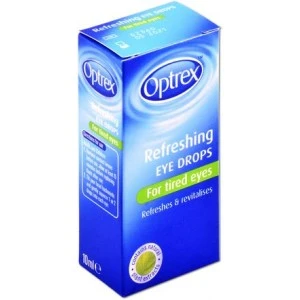Optrex Refreshing eye drops
- Click on the green "Get Started" button, then click "Start Consultation" button on the next page.
- Fill in our short consultation form.
- Choose delivery method and mode of payment.
- Our team of expert prescribers will assess whether medication is suitable.
- If you get the green light and it is deemed suitable, your order will be processed quickly and efficiently.
Your privacy is important, Prescription Doctor are committed to keeping your details completely confidential.
This is why we also take steps to conceal your prescription products under two layers of packaging.
We have a commitment to delivering a discreet service and understand your need for privacy. We ship all orders via a trackable courier using discreet, plain packaging.
Once your order is dispatched you will receive a tracking number via sms and email.
We deliver medications between Monday and Saturday. You can upgrade to Saturday delivery on Friday.
You should receive a tracking number with your order which you can use this number to track your parcel online. This should give you a clear indication of where your parcel is. If you haven’t received your parcel in the time frame given by our couriers, contact your local depot to find out where it is. You can also contact our support team who will do this for you.
On checkout you will be asked to leave your mobile number so our courier can text you about the delivery. This is also useful if the courier has problems finding your address. We will not use your mobile number for anything else.
You can pay for your order using credit, debit card or via bank transfer.
If you don’t have a credit or debit card you can pay via bank transfer. We will give you a unique reference number at checkout along with details of how to make the transfer. Once the money has cleared in our account, we will process your order.
We are a completely secure site and take many measures to ensure your details are kept safe. We understand that you have a right to extreme privacy when purchasing sensitive health medications. All information that you provide to us is stored on our secure servers. Any payment transactions will be encrypted using SSL technology.
You can pay for your order using credit, debit card and bank transfer.
Card Payment: Please notify us that you wish to cancel your order. Your refund will show available In 1 - 3 days.
Bank Transfer: A member of our team will contact you requesting for your bank details. These details are only used to transfer the funds back into your account.
Table of contents:
Tired and uncomfortable eyes are a common ailment and an unfortunate crutch of modern life. While there are numerous ways to reduce your risk of eye fatigue, it can still occur from time to time.
Screen eyes
Screens are everywhere - from your work desk to your pocket. They're often unavoidable and sometimes essential to our daily lives, but they can put strain on the eyes.
You might assume that blue light is the sole perpetrator of eye fatigue, but it is only one of several aspects of a display which can affect you.
Blue light is harsh and prevents our body from producing enough melatonin to induce sleep. Moreover, staring at screens increases the likelihood of the protective fluid layer of the eye, known as the tear film, evaporating. The tear film helps to lubricate the eyelids.
You can reduce the amount of blue light on your screen by using a blue light filter, which is built into most devices. This setting will gradually tint your screen red (the opposite of blue on the colour wheel) to essentially neutralise the colour and relieve some eye strain. It can be set to come on in the evening to help your body produce more melatonin.
Some monitors allow you to adjust the "temperature" of the display. Most displays are between 6500 and 9500 kelvins (K). The lower the number, the warmer the image. If you are struggling with eye strain, try lowering the temperature of your display.
Refresh rate is a major contributor to eye strain. The refresh rate is the speed at which your screen redraws the image, typically represented in cycles per second (Hz). Most modern screens are set at 60Hz, which is usually adequate. If you are using a CRT monitor, try increasing the refresh rate to reduce eye strain.
You should also keep your head a fair distance away from your monitor to prevent unnecessary eye strain. If you are struggling to see the screen, try increasing the text and icon scaling.
Dry environments
Air conditioning and central heating keep our bodies at an optimum temperature (~32 °C), but they also reduce the humidity in the air. Dry and still air can contribute to the evaporation of the tear film, leading to dry eyes.
If possible, use a humidifier to create moist air in the room. During the summer, you can leave a bowl of water on the windowsill - the sun will evaporate the water into the air.
Equally, cold and windy weather can cause eye dryness. While wind can trigger your tear ducts to produce more tears, it can also push the existing tear film away from the cornea and to the edges of the eye. Cold and still air can have a similar effect to warm still air.
The air conditioning found on planes, combined with the possible change in climate and jet lag, can all contribute to dry and uncomfortable eyes.
If you are going on holiday, you can take eye drops with you in your hand luggage. We advise you to check the UK government website for information on carrying medicine onto planes; you can find it here.
Sleep disturbances
Jet lag and lack of sleep cause your eyes to feel tired, as they remain open for longer than they would normally. In most cases, getting a good few hours can help your eyes rest and replenish the tear film.
Sleeping in a cool, dark environment can help you get a good night's sleep. You can try placing a quiet fan in your room to circulate cool air throughout the space. Alternatively, you can open your bedroom window during the warmer months to keep your body cool.
Try to reduce the amount of light in your room by turning off electronic devices, such as TVs and computers. Also, keep the screen on your phone off while it's charging.
If you have a habit of using your phone in bed, try switching to reading a book or using an e-reader with an e-ink display to give your eyes some respite from screen glare.
Avoiding caffeine and alcohol an hour before bed can help you settle into a peaceful slumber and give your eyes the rest they need.
Particles and pollution
Small particles in the air, such as smoke, dust, and air pollution, can irritate the eyes, causing them to feel tired and irritated.
Smoke from cigarettes and barbecues for long periods can irritate your eyes and gradually lead to eye tiredness. Air pollution can similarly affect the eyes.
If possible, avoid areas with pollution. If you can't avoid smoky, dusty or polluted environments, take precautions to mitigate your risk of getting dust and smoke in your eyes by wearing adequate eye protection.
Wrap-around sunglasses and goggles can block particles from coming into contact with your eyes. Sun hats, baseball caps and similar headwear can also prevent particles from getting in your eyes.
Medicine and chemicals
Some medicines can cause dry and tired eyes. A full list of associated side effects can be found within the patient information leaflet enclosed within the packaging of your medication. If you are unsure, ask your doctor or a pharmacist for advice.
Regular exposure to strong cleaning products, such as bleach or chlorine, or strong foods like chopped onions, chillies, and garlic can contribute to or worsen tired eyes. In these instances, consider wearing appropriate eye protection or limiting your exposure to these irritating substances. You can also try ventilating the environment by opening a nearby window.
How do Optrex refreshing eye drops work?
Optrex refreshing eye drops contain a natural ingredient called Hamamelis water, also known as distilled witch hazel, as well as other natural ingredients.
Distilled witch hazel provides a cool and soothing sensation to the eyes. The fluid also helps to lubricate the eyelids and bring relief from the feeling of tiredness.
Optrex refreshing eye drops will not treat eye infections, such as conjunctivitis, and can only help relieve symptoms of tired eyes. If you regularly experience eye strain and fatigue, consult your doctor to determine the cause and make necessary adjustments.
How do I use Optrex eye drops?
You should always wash your hands before applying eye drops to prevent debris from entering your eye.
If you wear contact lenses, take them out before applying Optrex eye drops. You can reinsert your contact lenses 15 minutes after applying the drops.
Tilt your head back, look up and pull your lower eyelid down.
Holding the dropper directly over your eye, gently squeeze to administer 1 or 2 drops into your eye.
Close your eyes for 1 or 2 minutes.
Repeat these steps for your other eye if necessary.
Side effects and cautions
All medicines carry the potential risk of side effects, though not everybody experiences them. Being aware and vigilant of any potential side effects is an important part of your care.
Side effects of Optrex sore eyes may include:
- Discomfort after applying the drops
- Mild stinging after applying the drops
- A short period of blurred vision after applying the eye drops
This is not an exhaustive list of side effects. Further information regarding the safety of this medicine can be found within the enclosed pamphlet with your treatment.
If you experience any side effects, regardless of whether they are listed above or in the supporting literature, inform your doctor or ask a pharmacist for assistance.
Allergic reaction
Do not use Optrex Sore Eyes eye drops if you are allergic to distilled witch hazel or any of the other excipients of this medication.
If you experience an allergic reaction to Optrex Sore Eyes eye drops, stop using them and seek immediate medical attention.
Signs of an allergic reaction include:
- Swelling of the face, lips, tongue or throat
- Wheezing or difficulty breathing
- Raised, itchy, red rash (hives)
- Dry, red, and cracked skin
- Tightening of the chest
Pregnancy and breastfeeding
If you are pregnant, think you might be pregnant or breastfeeding, speak to your doctor or a pharmacist before using Optrex Sore Eyes eye drops.
Other safety information
Always consult your doctor before purchasing Optrex Sore Eyes eye drops online.
If you need to use Optrex Sore eye drops for longer than 14 days, speak to your doctor.
Always store the bottle in the original carton away from sunlight.
Take care when handling ocular solutions. If handled improperly, the bottle can become contaminated with common bacteria, leading to eye infections.
Be careful not to touch the tip of the bottle on your eye or any other surface.
Always replace the cap securely after use.
Do not use Optrex eye drops past the expiry date printed on the packaging.
Do not use Optrex eye drops for more than 4 weeks after opening the bottle.
Never throw away medicine via household or water waste. Ask your local pharmacy to safely dispose of any unwanted or expired medicine on your behalf.
Always keep medicine out of the sight and reach of children and pets.
Frequently asked questions
What should I do if I forget to take Optrex when I should?
If you forget to use Optrex, use it as soon as you remember and continue to use it as you normally would. Do not apply more eye drops to make up for the ones you forgot.
What should I do if I apply too many eye drops?
If you apply more than one drop to the eye, speak to your doctor or pharmacist for advice.
Can I drink alcohol while taking Optrex?
While alcohol is unlikely to affect Optrex, alcohol can cause dehydration, which may exacerbate the symptoms of dry eyes.
Can Optrex be used with contact lenses?
Remove your contact lenses before applying the eye drops. Wait 15 minutes before reinserting your contact lenses.
Treatment information
- Product Name: Optrex Refreshing eyes
- Manufacturer: Reckitt Benckiser
- Active Ingredient(s): Distilled witch hazel
- Administration: Ophthalmic
- Presentation: Eye drops
- Available Strength: 13% v/v
- Exemption: Pharmacy
- Dosage: 1 drop in each eye
- Description: Optrex refreshing eye drops provide relieve from fatigue and discomfort in the eyes.
- Alcohol Consumption: No influence
- When Pregnant: Speak to your doctor or a pharmacist before using Optrex eye drops if you are pregnant, think you might be pregnant or plan on starting a family.
- When Breastfeeding: Speak to your doctor or a pharmacist before using Optrex eye drops if you are breastfeeding.
- Price: 5.99 GBP
Authored & Reviewed By

Mohamed Imran Lakhi
MPharm - Lead PharmacistPublished on: 13/02/2020 Reviewed on: 13/03/2024
Eye care Alternatives
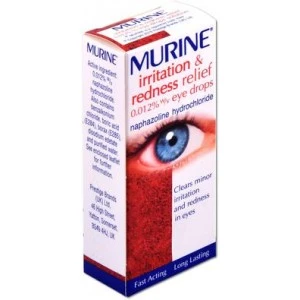
Murine irritation and redness eye drops
- No prescription required
- Dispatched from a UK registered pharmacy
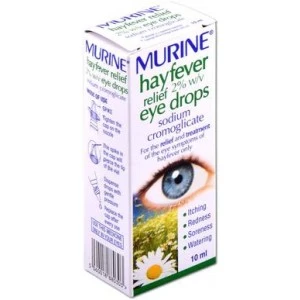
Murine Hayfever eye drops
- No prescription required
- Dispatched from a UK registered pharmacy
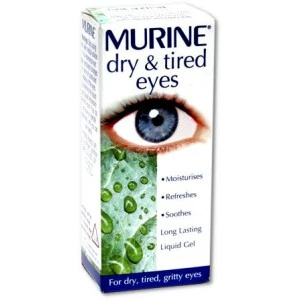
Murine dry and tired eye drops
- No prescription required
- Dispatched from a UK registered pharmacy
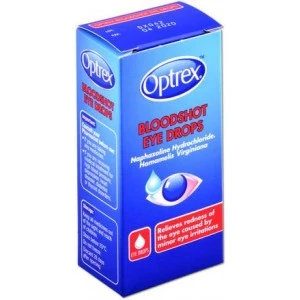
Optrex Bloodshot eye drops
- No prescription required
- Dispatched from a UK registered pharmacy
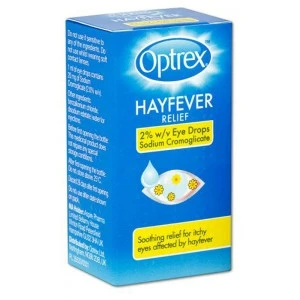
Optrex Hayfever relief eye drops
- No prescription required
- Dispatched from a UK registered pharmacy
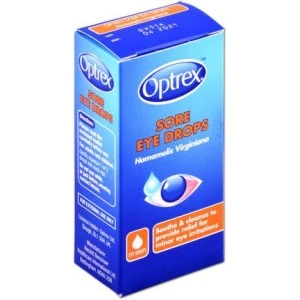
Optrex sore eye drops
- No prescription required
- Dispatched from a UK registered pharmacy
© 2013 - 2025 Al Muhsineen Limited. All Rights Reserved. Registered Pharmacy: 34 Halliwell Road, Bolton BL1 8RL. Registered Office: 254 First Floor, Shearbrow, Blackburn, England, BB1 8DS

